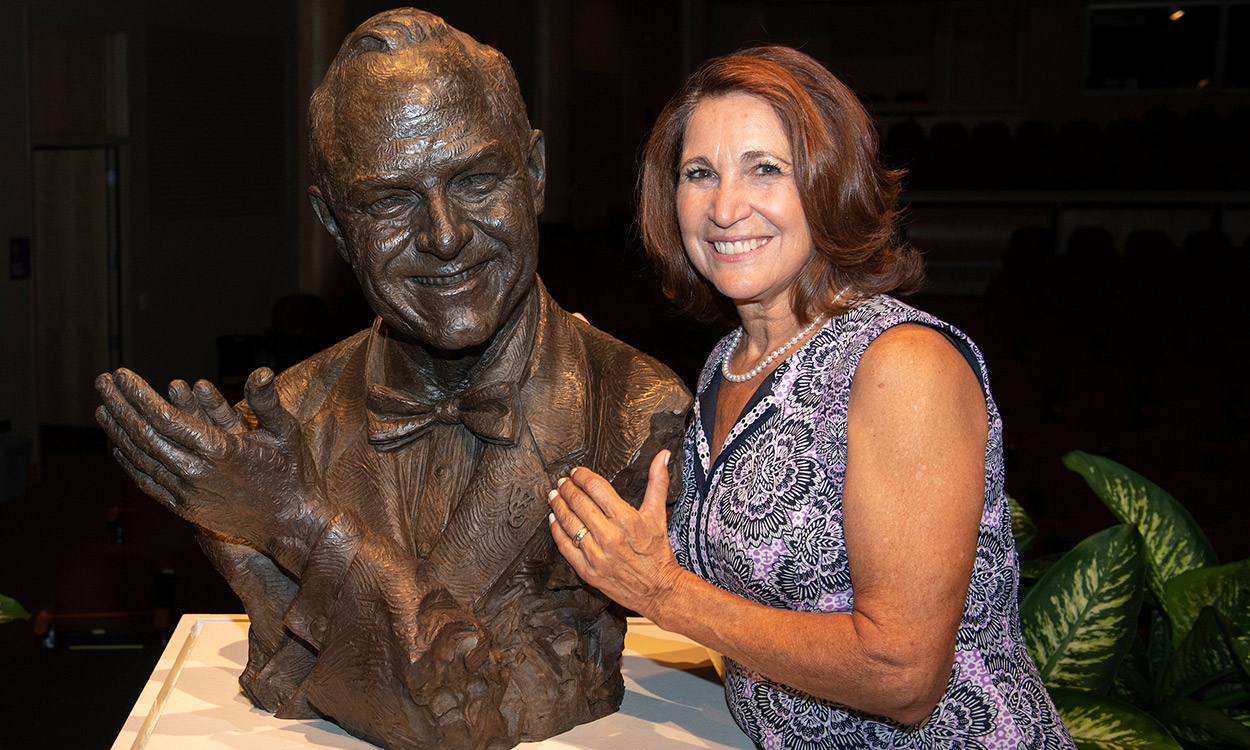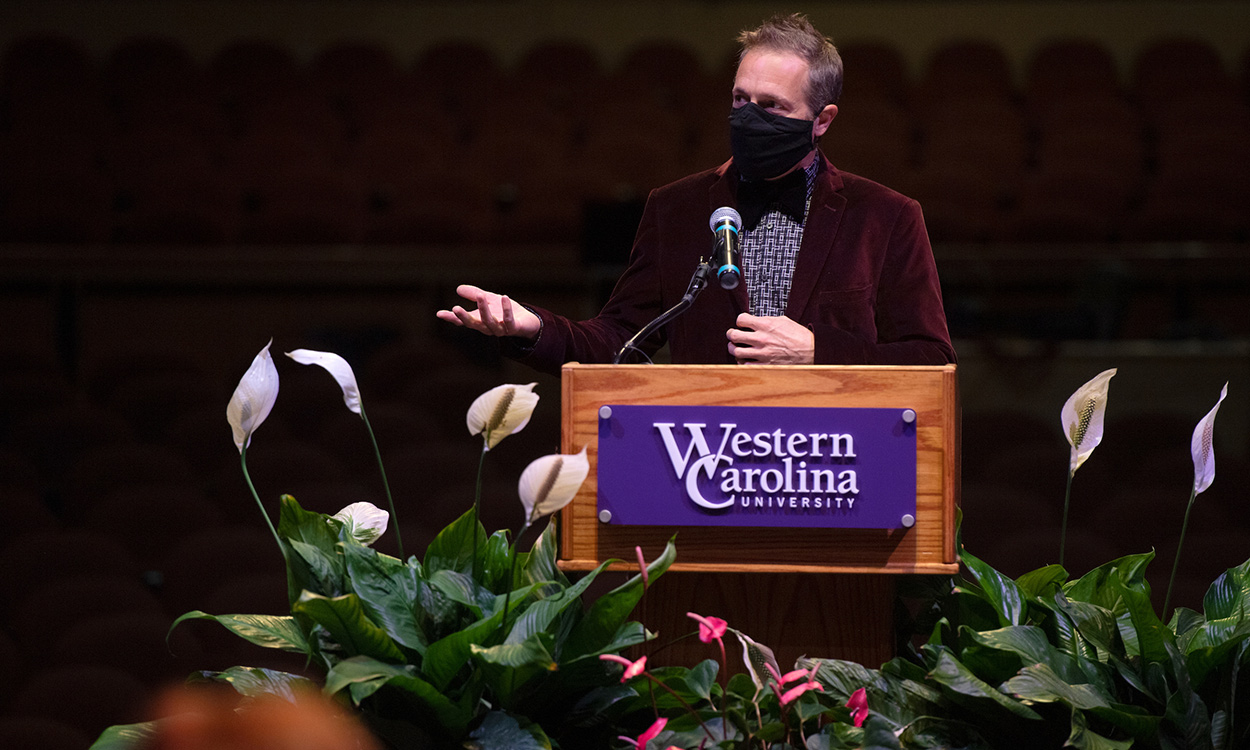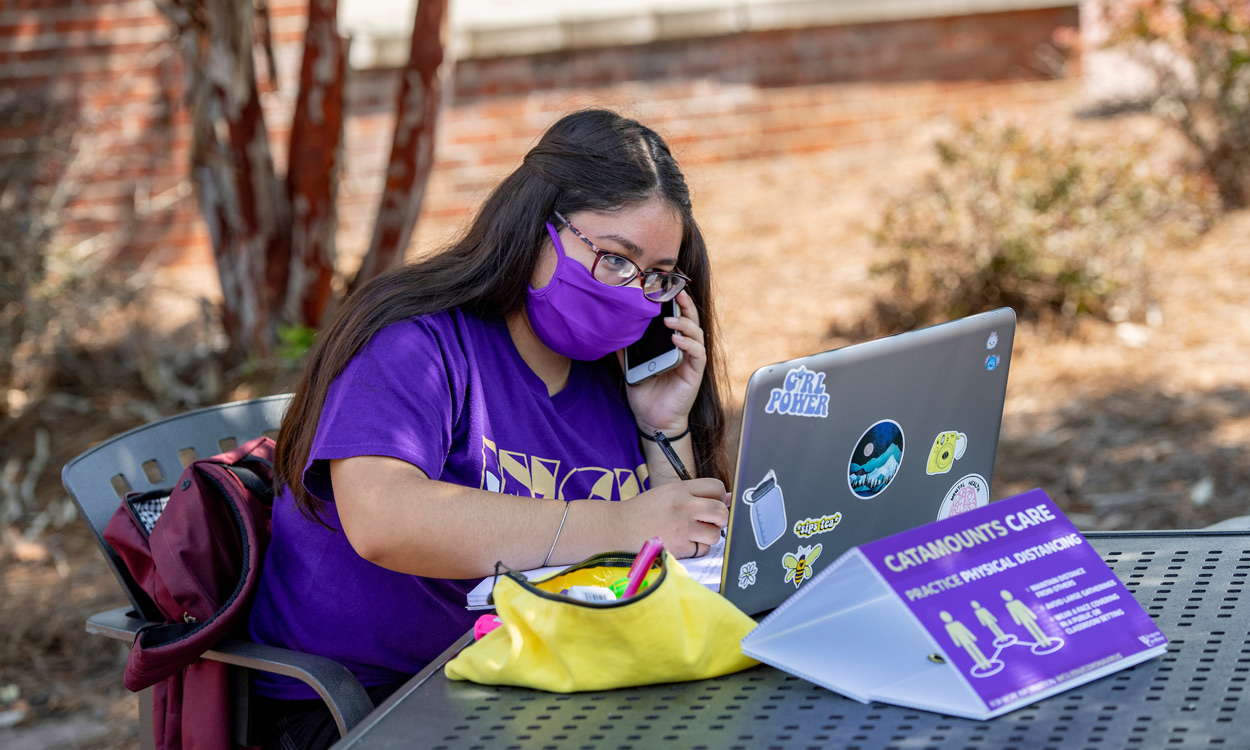Bronze sculpture captures essence of late Chancellor David Belcher
By Melanie Threlkeld McConnell

Susan Belcher poses with a bronze sculptural bust of David O. Belcher, the late former chancellor of Western Carolina University.
It’s all there. The twinkling eyes, the nose—especially the nose—the bitten fingernails, the wedding band on his left hand and the little tufts of hair trying so hard to stand up straight, but leaning over as if to rest for just a moment from the endless energy radiating from the man upon whose head they sit.
Yes, it is all there — the glorious essence of David Belcher, beloved former chancellor of Western Carolina University who died June 17, 2018, from brain cancer, in an uncanny look-alike bronze sculptural bust that will be installed at the John W. Bardo Fine and Performing Arts Center later this fall.
The bust was unveiled recently in a small ceremony involving the late chancellor’s family, including his wife, Susan; WCU Chancellor Kelli R. Brown; other university officials; and the sculpture’s creator, artist Wesley Wofford, an Emmy and Academy award-winning sculptor whose work has been exhibited throughout the United States. A public installation of the sculpture will be held in the future when restrictions related to the COVID-19 pandemic are eased.
“It’s a true honor to participate in this. To be able to commemorate someone I actually knew is very rare for me,” said Wofford, who lives in Cashiers. “A lot of my portrait commissions tend to be historical figures or famous people.”
Wofford said he and his wife, Odyssey, met David and Susan Belcher a few years ago at an event and discovered they were “cool people, they were like our peeps.” Belcher then invited the Woffords and their children to sit with him and Susan in the chancellor’s box at a WCU football game, which is where, Wofford said, he began to understand who David Belcher really was.
“David is such a beautiful person,” Wofford said, recalling the way Belcher connected with his kids. “He invited them to go down and interact with the student section,” Wofford said. “I was just amazed. At my college, I didn’t even know my chancellor’s name. These students engaged with him in a way that was so inspiring and impressive, which is who he was.”

Artist Wesley Wofford approached Susan Belcher and offered to make the sculpture.
After Belcher died, Wofford said he approached Susan and offered to make the sculpture. He worked with Susan; George Brown, dean of the David O. Belcher College of Fine and Performing Arts; and Denise Drury Homewood, director of the John W. Bardo Fine and Performing Arts Center, to talk through what they wanted the sculpture to convey and what spark in Belcher they wanted to capture. The fact that Belcher was a classically trained pianist — an artist before he was a university administrator — was never far from the discussion.
“He was both an audience member and a performer,” Wofford said. “He had been on this stage playing and he also sat out in the audience and was proud of his students. So, there was this humble gratitude that we wanted the sculpture to convey. We wanted to touch on both sides of his coin as performer and audience member.”
And the sculpture does, so movingly, through its depiction of Belcher’s hands — the conduits, so often, for his frenetic energy — racing across the piano keys, raised high and clapping in celebration of a Catamount goal, clutching the banned-to-students air horns he loved to blare at graduation ceremonies, or patting the shoulders of students he was often asked to pose with for pictures.
In the sculpture, which has Belcher dressed in a tuxedo with a little WCU pin on his lapel, his hands are upright and clasped together. Is he clapping for someone or expressing his gratitude? Both, Wofford said. “In one way, he’s watching a performance from his students. He’s so proud of what they’re doing and so impressed, he’s clapping like that was an amazing performance. At the same time, he has finished playing his piece and everyone is clapping for him and he is graciously saying ‘thank you’ by bringing his hands together.”
Susan Belcher said the vision Wofford captured of her late husband applauding the achievements of others took her breath away. “It was the most beautiful, moving experience to watch Wesley’s depiction of David as an artist and educator emerge from Wesley’s hands and heart,” she said during the ceremony. “He took immense care in the smallest, nuanced detail and was open to all input to capture David truthfully.
“I have to tell you, David was hard on himself as an artist. He was a very disciplined and in many ways exacting artist who didn’t ‘play for fun,’” Susan said. “Art was a serious discipline to him and if he couldn’t bring his best to it, he would not do it. And he was very demanding of his students, his staff and his faculty. David believed, and he told me this so many times, that people rise to the expectations you place upon them. And, boy, could he place the expectations high.”
The sculpture, once installed, will be the 13th sculpture in the WCU Fine Art Museum’s outdoor sculpture collection, said Drury Homewood, adding that the project was unanimously approved by the WCU Public Art Committee. It took Wofford nearly two years to complete from concept to the final bust being delivered. He used clay to create the original sculpture from which the bronze cast was made.
Was it emotionally hard to work on such an intimate project involving a friend who had died? “Sculpting anyone is always an emotional experience as I attempt to channel them into the sculpture, but with David it was particularly intense because I could hear his laugh and feel his warmth,” Wofford said in an email. “There was an element of tragedy to capturing his likeness, but I had so many nostalgic pictures of his life that it felt more like a celebration. It actually was a very happy experience for me to live in his headspace because of his beautiful soul.”
Information about a public installation of the sculpture will be announced at a later date.

